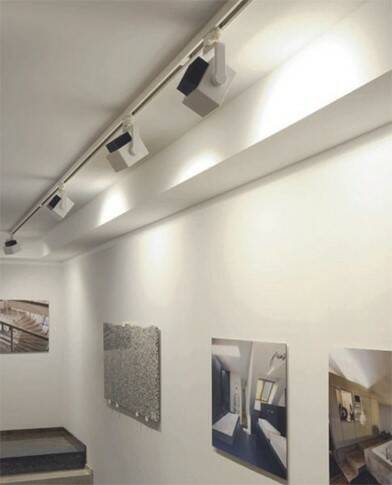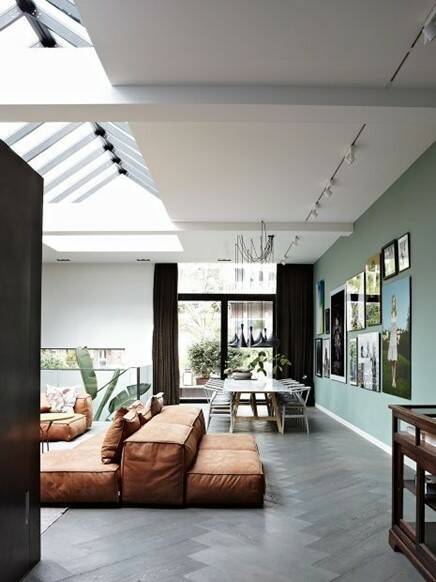- Home
- / Blog
- / Interior Design
Track Lighting for Your Home Art Gallery
01/10/2022
Staging a home art gallery is a great way to spend more time enjoying your most valued pieces and find creative ways to show them to their best advantage. If you can, ask a lighting designer to create a 3D model of your space; this model will help you visualize before plunging in to purchases and hiring electricians. Start planning your space, envision your gallery, choose the right spot for every art piece, and most importantly really invest in at least one element of art lighting. The specialized art lighting you see in galleries is purposely positioned to create highlights and dramatic focal points. For this purpose, track lighting, including specialty focusing projectors, is often deployed, even if only for certain layers, spots, or washes of lighting in the room. Track light projectors are designed with different focal adjustments such as beam angle changes and can have additional flat lens accessories (including color lenses and frosted). Aside from providing great accent lighting., track lights are minimalist, sleek, and functional in their design and come in several finish choices that can match the track, which can match or contrast with the ceiling. In this article I want to show how to use track lighting in your home gallery, as well as show you some track lighting ideas to get your creativity going
1. If Museums Do It Why Can't You?
The main task of art gallery lighting is, of course, to illuminate the exhibits. It is important to emphasize their characteristics and beauty, as well as to reduce the damage caused by light (especially UV light and partly also IR light) on exhibits. In addition, lighting also has the task of emphasizing the architectural features of the space while creating a pleasant and safe ambience. Because track lighting is unobtrusive and relatively easy to install directly into the ceiling, it is the preferred mode that is often used for museum lighting. For the safety of their art masterpieces, museums choose LED track heads, these LED lamps with warm beam spread are perfect for accentuating without damaging.
2. When Lighting Objects - Don't Neglect Their Surroundings
When illuminating paintings and other objects displayed on the walls, the first consideration should be for even and adequate illumination of the surface of the exhibited object. But it is also important to plan for adequate lighting of the object's surroundings to prevent too strong (or too weak) contrasts. Mostly one of the two approaches described below for this type of lighting is used, but a combination of both is also possible.

3. Choose Your Approach - High vs Low Illumination
The first approach in designing lighting for galleries is based on the relatively high illumination of objects with very diffused light of neutral white or cool white color (higher color temperature). Due to its high illuminance, it can be used mainly for illuminating exhibits that are not very sensitive to light (for example, in galleries with contemporary or modern art, art that is not painted on canvas).
Another approach is used for medium and very sensitive exhibits (which are mostly also older). To reduce the cumulative exposure to light, focus it only on the exhibits. The environment is much darker in this case. therefore, even with less illumination of the exhibits, appropriate contrasts can be achieved. In this case, the lighting consists of directional lamps mounted on a ceiling or suspended track lighting system.

We can also use lamps that are mounted on the wall above the exhibits (pictures). As the overall illuminance is much lower, a lower (warmer) color temperature of the light sources is recommended (3000 K or less). Lighting for artwork that attaches behind frames or to the wall can be very individualized to your artwork, sometimes a home gallery can be built around one or more gallery lights. Perfectly planned gallery lighting can be built around good ideas, look here for some interesting gallery wall custom light applications.
In the case of lighting with artificial light, track lights with indirect luminaires or luminaires with a large bright surface are suitable.
If you want to learn more about lighting design, you can check our article on Principles of lighting design.
3. Understand The Nature of Glare and Reflection
Another important thing when designing your gallery lighting is glare. Glare occurs when illuminating any object that is covered in glass. Protecting artwork can often mean dealing with glare and reflections of bulbs despite your best efforts to avoid. In cases where the exhibits are covered or protected with safety glass the resultant glare is especially difficult. In such cases, we need to think carefully about the angle at which visitors will observe the object and adjust to this angle the angle of incidence of light and the location of the lamps. In such a case, the use of flat glass in display cases is also recommended, as with semi-circular or cylindrical glass, reflections are more difficult to control. In the case of uncovered exhibits, it is also necessary to pay attention to reflections, as these can occur on the very surface of the illuminated object. To read more about art, lighting artwork and choosing the right light source you can see some of our articles below.
.jpg)

4. Create A Gallery In Your Living Room
It’s always nice to make part of your living room a gallery, where you will enjoy showing your taste, and your guests will have a chance to see your art collection and family portraits. In this case, since you have two separate rooms incorporated into one, you need to adjust the lighting as well. As lighting designer, I would advise for the main task areas like dining area and sitting area to choose lights that will be task lighting focused, like eating or reading a book and at the same time the light will not bother someone watching TV or looking at your paintings. To achieve this, you can use track lights, since they can be focused on certain positions for certain activities.
If you never knew it before, you will be surprised at how functional and aesthetic a track light can be. For the paintings there is a track light focused on them, and for the dining table there are suspended lights so that they won’t interfere when someone is looking at the pictures. Here, you can also see the practicality of track lighting, for instance if you are not satisfied with the illumination of a certain area or have new art piece that needs to be specially illuminated, simply add another light to the track and create a perfect picture light. For more ideas regarding the incorporation of art with interior design read more here: Nine Ways Art Rules Interior Design by Winny Okoth.
________________________________________________________________________________________________
 Teodor Toshev - I am an electrical engineer from N. Macedonia, currently pursuing my masters degree in electrical power engineering in Ljubljana, Slovenia. I work with design of electrical installations and lighting. I spend my free time writing articles and working on smaller projects for lighting and interior design. I love to communicate and work with people, travel and learn new things.
Teodor Toshev - I am an electrical engineer from N. Macedonia, currently pursuing my masters degree in electrical power engineering in Ljubljana, Slovenia. I work with design of electrical installations and lighting. I spend my free time writing articles and working on smaller projects for lighting and interior design. I love to communicate and work with people, travel and learn new things.


